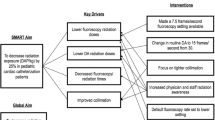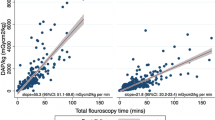Abstract
The aims of this study were to quantify patient radiation exposure for a single interventional procedure during transition from an adult catheterization laboratory to a next-generation imaging system with pediatric settings, and to compare this radiation data to published benchmarks. Radiation exposure occurs with any X-ray-directed pediatric catheterization. Technologies and imaging techniques that limit dose while preserving image quality benefit patient care. Patient radiation dose metrics, air kerma, and dose–area product (DAP) were retrospectively obtained for patients <20 kg who underwent patent ductus arteriosus (PDA) closure on a standard imaging system (Group 1, n = 11) and a next-generation pediatric imaging system (Group 2, n = 10) with air-gap technique. Group 2 radiation dose metrics were then compared to published benchmarks. Patient demographics, procedural technique, PDA dimensions, closure devices, and fluoroscopy time were similar for the two groups. Air kerma and DAP decreased by 65–70 % in Group 2 (p values <0.001). The average number of angiograms approached statistical significance (p value = 0.06); therefore, analysis of covariance (ANCOVA) was conducted that confirmed significantly lower dose measures in Group 2. This degree of dose reduction was similar when Group 2 data (Kerma 28 mGy, DAP 199 µGy m2) was compared to published benchmarks for PDA closure (Kerma 76 mGy, DAP 500 µGy m2). This is the first clinical study documenting the radiation reduction capabilities of a next-generation pediatric imaging platform. The true benefit of this dose reduction will be seen in patients requiring complex and often recurrent catheterizations.
Similar content being viewed by others
References
Andreassi MG, Ait-Ali L, Botto N, Manfredi S, Mottola G, Picano E (2006) Cardiac catheterization and long-term chromosomal damage in children with congenital heart disease. Eur Heart J 27:2703–2708
Andreassi MG, Cioppa A, Manfredi S, Palmieri C, Botto N, Picano E (2007) Acute chromosomal DNA damage in human lymphocytes after radiation exposure in invasive cardiovascular procedures. Eur Heart J 28:2195–2199
Bacher K, Bogaert E, Lapere R, De Wolf D, Thierens H (2005) Patient-specific dose and radiation risk estimation in pediatric cardiac catheterization. Circulation 111:83–89
Ghelani SJ, Glatz AC, David S et al (2014) Radiation dose benchmarks during cardiac catheterization for congenital heart disease in the United States. JACC Cardiovasc Interv 7:1060–1069
Gislason AJ, Davies AG, Cowen AR (2010) Dose optimization in pediatric cardiac X-ray imaging. Med Phys 37:5258–5269
Glatz AC, Patel A, Zhu X et al (2014) Patient radiation exposure in a modern, large-volume, pediatric cardiac catheterization laboratory. Pediatr Cardiol 35:870–878
Johnson JN, Hornik CP, Li JS et al (2014) Cumulative radiation exposure and cancer risk estimation in children with heart disease. Circulation 130:161–167
Justino H (2006) The ALARA concept in pediatric cardiac catheterization: techniques and tactics for managing radiation dose. Pediatr Radiol 36(Suppl 2):146–153
Kobayashi D, Meadows J, Forbes TJ et al (2014) Standardizing radiation dose reporting in the pediatric cardiac catheterization laboratory—A multicenter study by the CCISC (Congenital Cardiovascular Interventional Study Consortium). Catheter Cardiovasc Interv 84:785–793
Mauriello DA, Fetterly KA, Lennon RJ et al (2014) Radiation reduction in pediatric and adult congenital patients during cardiac catheterization. Catheter Cardiovasc Interv 84:801–808
Onnasch DG, Schemm A, Kramer HH (2004) Optimization of radiographic parameters for paediatric cardiac angiography. Br J Radiol 77:479–487
Partridge J, Mcgahan G, Causton S et al (2006) Radiation dose reduction without compromise of image quality in cardiac angiography and intervention with the use of flat panel detector without an antiscatter grid. Heart 92:507–510
Sawdy JM, Kempton TM, Olshove V et al (2011) Use of a dose-dependent follow-up protocol and mechanisms to reduce patients and staff radiation exposure in congenital and structural interventions. Catheter Cardiovasc Interv 78:136–142
Schueler BA, Julsrud PR, Gray JE, Stears JG, Wu KY (1994) Radiation exposure and efficacy of exposure-reduction techniques during cardiac catheterization in children. AJR Am J Roentgenol 162:173–177
Streffer C (2007) International Commission on Radiation P. The ICRP 2007 recommendations. Radiat Prot Dosim 127:2–7
Verghese GR, McElhinney DB, Strauss KJ, Bergersen L (2012) Characterization of radiation exposure and effect of a radiation monitoring policy in a large volume pediatric cardiac catheterization lab. Catheter Cardiovasc Interv 79:294–301
Conflict of interest
The authors have no conflicts of interest to disclose.
Author information
Authors and Affiliations
Corresponding author
Rights and permissions
About this article
Cite this article
Lamers, L.J., Moran, M., Torgeson, J.N. et al. Radiation Reduction Capabilities of a Next-Generation Pediatric Imaging Platform. Pediatr Cardiol 37, 24–29 (2016). https://doi.org/10.1007/s00246-015-1233-2
Received:
Accepted:
Published:
Issue Date:
DOI: https://doi.org/10.1007/s00246-015-1233-2




